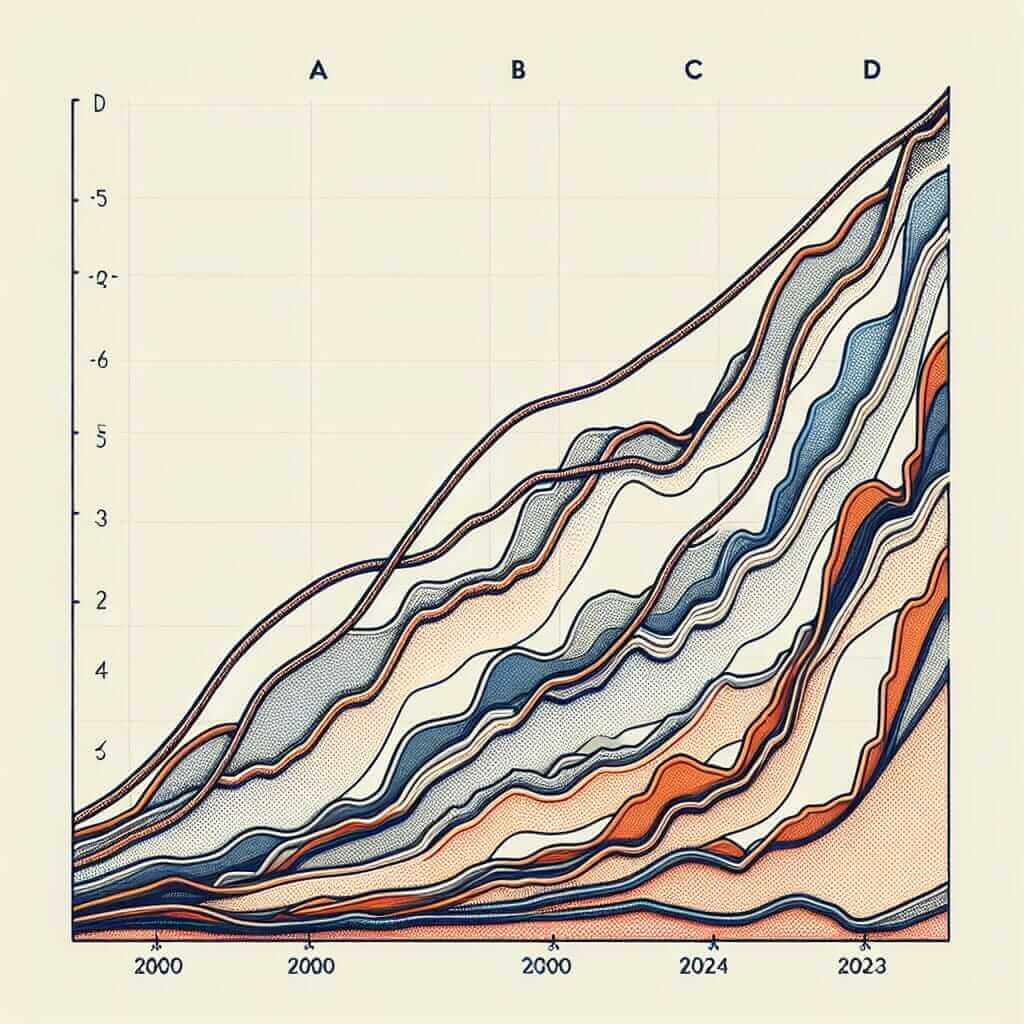In the IELTS Writing Task 1, candidates are often required to analyze and report information using data presented in charts, tables, or graphs. One common type of data that candidates might encounter is the economic growth rates of different countries over a given period. In this article, we will explore how to tackle such a task effectively, specifically focusing on the GDP growth rates of four countries from 2000 to 2023.
Common IELTS Writing Task 1 Question: GDP Growth Rates
You may encounter a prompt during your exam similar to the following:
Summarize the information by selecting and reporting the main features, and make comparisons where relevant. Write at least 150 words.
Sample Task
To help you prepare, let’s use the following hypothetical data:
| Year | Country A | Country B | Country C | Country D |
|---|---|---|---|---|
| 2000 | 3.5% | 2.8% | 4.2% | 5.1% |
| 2005 | 3.7% | 3.1% | 4.6% | 5.3% |
| 2010 | 3.6% | 2.9% | 4.8% | 5.5% |
| 2015 | 4.0% | 3.5% | 5.0% | 5.9% |
| 2020 | 3.8% | 3.2% | 4.9% | 6.0% |
| 2023 | 4.1% | 3.0% | 5.1% | 6.2% |

Analyzing the Task
When you encounter a task like this, your goal is to identify the main trends and compare the data effectively. Here are some key steps to consider:
- Introduction: Paraphrase the task prompt.
- Overview: Identify the main trends or notable changes.
- Details: Provide specific details and comparisons.
Writing the Introduction
In the introduction, paraphrase the task to set the context.
Example:
The table illustrates the GDP growth rates of four different countries (Country A, Country B, Country C, and Country D) from the year 2000 to 2023.
Writing the Overview
The overview section should highlight the key trends and significant changes observed across the period.
Example:
Overall, all four countries experienced growth in their GDP rates over the 23-year period. Notably, Country D consistently had the highest growth rates, while Country B and Country A had relatively lower rates of increase.
Writing the Details
In this part, provide specific data points and make comparisons.
Example:
In 2000, the GDP growth rate of Country D was the highest among the four countries at 5.1%, followed by Country C at 4.2%, Country A at 3.5%, and Country B at 2.8%. By 2023, Country D continued to lead with a growth rate of 6.2%. Country C followed with an increase to 5.1%, Country A improved to 4.1%, and Country B had the lowest growth rate at 3%.
Country D showed a steady upward trend, increasing from 5.1% in 2000 to 6.2% in 2023. Similarly, Country C’s GDP growth rate rose from 4.2% to 5.1%. In contrast, Country A and Country B fluctuated slightly, with Country A growing marginally from 3.5% to 4.1%, and Country B peaking in 2015 at 3.5% before declining to 3% by 2023.
Word Count: 214
Key Vocabulary and Grammar Notes
Vocabulary:
- Fluctuate (v) /ˈflʌktʃueɪt/ – to vary irregularly
- Steady (adj) /ˈstedi/ – not changing, continuous
- Marginally (adv) /ˈmɑːrdʒɪnəli/ – slightly, to a small extent
- Growth Rate (n) /ɡroʊθ reɪt/ – percentage increase in value over time
- Consistently (adv) /kənˈsɪstəntli/ – always happening in a similar way
Grammar:
- Sentence variety: Use a mix of simple, compound, and complex sentences to vary your writing style.
- Comparatives and superlatives: Use these appropriately to compare data points (higher, lower, the highest, the lowest).
Conclusion
Successfully approaching an IELTS Writing Task 1 question involving GDP growth rates involves breaking down the task into manageable parts. Start with a clear introduction, provide an overarching summary of trends, and dive into specific comparisons using appropriate vocabulary and grammar. With diligent practice, you can develop the skills needed to achieve a high band score.